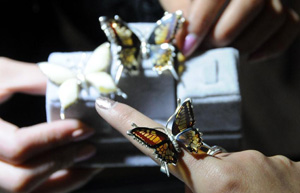3D printing helps reveal bacterial infections
Updated: 2013-10-08 09:51WASHINGTON -- US researchers said Monday they have devised a three dimensional microscopic printing technique to study how communities of bacteria, such as those in the human gut and lungs, interact and influence human health.
Bacteria in the human body often thrive within structured 3D communities that contain multiple bacterial species. Recent studies have found that relationships between structure and function in these microbial ecosystems can affect human health, such as the virulence of infections in chronic wounds.
To help study these relationships, researchers from the University of Texas developed a laser-based printing technology to build protein "cages" in gelatin for bacteria in almost any 3D shape or size.
Gelatin, a highly porous material, allows the enclosed cells to both grow rapidly and communicate with other species growing in separate, nearby enclosures.
"What's key is these structures aren't just controllable in terms of their geometries; they're also very bio-friendly," lead author Jason Shear, professor of chemistry at the university said in a statement.
"The walls that we make out of these protein molecules are linked together tightly enough to prevent the bacteria from escaping, but they are porous enough to be chemically permissive," Shear said.
"Nutrients can come in. Waste can go out. Signals can be exchanged. They're trapped in these tiny houses, but they function like they do in biological environments," he added.
The researchers said the new technique should enable an entirely new class of experiments that better approximate the conditions that bacteria encounter in actual biological environments, such as those in the human body.
They demonstrated that a community of Staphylococcus aureus, which can cause some skin infections, became more resistant to antibiotics when it was contained within a larger community of Pseudomonas aeruginosa, a bacteria involved in various diseases, including cystic fibrosis.
Among the long-term goals are to use the insights gleaned from such experiments to better combat infections in humans, the researchers said.
"Think about a hospital, which we know is not a good place to be to avoid infections," said Shear. "There are studies that seem to indicate that infections are transmitted by very small microcolonies of bacteria, which are likely transported by equipment or staff from one part of the hospital to another. We currently know little about how this is happening. How many cells does it take? Do these microcommunities become particularly virulent or antibiotic resistant precisely because they're small, and then in turn change the properties of bacteria on our skin or in our bodies? Now we have a means to start asking these questions much more broadly."
The findings were published in the journal Proceedings of the National Academy of Sciences.























